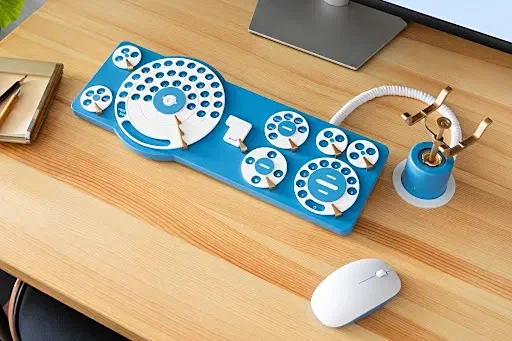Click here to buy secure, speedy, and reliable Web hosting, Cloud hosting, Agency hosting, VPS hosting, Website builder, Business email, Reach email marketing at 20% discount from our Gold Partner Hostinger You can also read 12 Top Reasons to Choose Hostinger’s Best Web Hosting
Typing is fast, familiar and — for most of us — monotonous. For makers, designers and people who tinker, the standard QWERTY keypress can feel limiting: every year we ask if input devices could be more expressive, more tactile, or simply more fun. That frustration grows when innovation is confined to software pixels while physical hardware stays the same. Enter the Gboard Dial Version — Google Japan’s cheeky, rotary-inspired keyboard concept that turns typing into deliberate rotational gestures and ships as an open-source DIY project. It’s not trying to replace your laptop keyboard; it’s offering a different way to think about input — and giving makers the blueprints to build it.
Apple Magic Accessories are a popular choice for Mac users who want a smooth experience and stylish setup. If you’ve ever wondered what makes the Magic Keyboard, Mouse, and Trackpad so unique, this article breaks it down simply. Let’s dive in.
What Google announced
On October 1, 2025, Google Japan published a new entry in its long-running series of playful Gboard hardware concepts: the Gboard Dial Version. The post describes a circular keyboard where characters and functions are selected by inserting a finger into a hole and rotating a dial — a clear nod to vintage rotary phones — while modern sensors convert rotation into digital input. The team frames the project as both a design experiment and a DIY kit: schematics, 3D files and firmware are available so anyone can build their own. blog.google
Google has historically released similar novelty input devices (teacup keyboard, double-sided Möbius keyboard, long single-row bar), and the company continues to publish the technical sources and manufacturing files in a public repository. The Gboard DIY project files (including a dedicated mozc-dial folder) live under Google’s mozc-devices GitHub repository, licensed for reuse and modification. GitHub

Why the Gboard Dial Version is more than a gimmick
1. It’s design research you can build
Google’s project is explicitly experimental, but it’s also practical: open files let hobbyists, accessibility researchers, and small manufacturers test the design in the real world. That democratizes hardware research — you can iterate on the dial shape, sensor mapping, or layout without waiting for a vendor to commercialize it. The GitHub repo contains PCB layouts, firmware and 3D parts so the community can tinker. GitHub
2. Rotary input reframes speed vs. intention
Rotary dialing is inherently deliberate: a rotation takes time and returns to rest. That “temporal cost” is usually a disadvantage for fast typing, but it becomes an advantage when intention matters — e.g., composing short messages on a couch, disciplines that benefit from slower input (transcription review, creative prompts), or situations where accidental keypresses are problematic. The Dial Version explicitly leans into that deliberate pacing, converting the mechanical return-time into a deliberate UX affordance. blog.google
3. It’s fertile ground for accessibility experiments
For some users with limited fine motor control, a twist or big rotary motion may be easier than precise key-presses. Because the project is open source, accessibility researchers can experiment with dial sizes, torque, and assistive mounting solutions, then publish findings so the community benefits. The hardware-first approach opens paths for alternative input standards beyond the touch or click metaphors.
How to Use Google Pomelli for FREE
4. An open platform for creative mashups
Because the repo includes firmware and mechanical files, we can already imagine niche derivatives: dial controllers for DJs, macro dials for streaming setups, rotary interfaces for elderly users, or tactile storytelling devices in museums. The Dial Version’s modular dials and separate function rotators make it ripe for creative re-use.
How it works
Physical form: a circular panel with multiple dial holes; users insert a finger and rotate to select characters or functions. The team addressed the scaling problem (more characters need more space) by stacking or multiplexing dials to keep the device compact. blog.google
Electronics & firmware: sensors track angular rotation and return motion; firmware converts rotational gestures into USB HID events. Google published PCB schematics and firmware in the mozc-devices repo so builders can assemble and flash their own boards. GitHub
DIY tooling: 3D printing files, a bill of materials and assembly guides accompany the release so makers can fabricate and test without proprietary tooling. GitHub
Logitech MX Keys Advanced Wireless Illuminated Keyboard for Mac
Mini case study: what a maker can do this weekend
Clone the mozc-devices GitHub repo and inspect
mozc-dial.Print a test dial using a cheap SLA/FFF printer to validate hole sizes.
Use an off-the-shelf microcontroller (Raspberry Pi Pico or similar) and follow the repo’s wiring guide.
Map one dial to a character set (e.g., vowels), another to modifiers (Shift/Ctrl), and test text entry speed vs. error rate.
Within a weekend, a reasonably equipped maker can build a proof-of-concept and contribute modifications back to the repo.
Design tradeoffs
Typing speed: Rotary input will never beat touch typing for raw speed. This design isn’t about replacing QWERTY for heavy text entry.
Learning curve: Users must learn entirely new motor patterns. The novelty may delight early adopters but limit mainstream uptake.
Durability & noise: Mechanical rotations and springs bring wear and larger acoustic signatures than membrane keys. Good for makers who like audible feedback; not ideal for quiet spaces.
Space & ergonomics: Multiple dials change wrist posture; prolonged use should be studied to avoid strain.
What this signals for input design
Opinion: Google Japan’s continued release of playful hardware prototypes pushes the broader UI community to treat input as a design variable, not a solved problem. By open-sourcing the designs, Google effectively crowdsources the experimentation stage: researchers and makers will produce variants that surface real use cases (assistive tech, live performance controllers, education tools). Over time, elements from these experiments — tactile rotary feedback, multi-modal inputs, modular physical UIs — could find their way into specialized commercial peripherals or accessibility products.
Key Takeaways
Gboard Dial Version is Google Japan’s October 1, 2025 DIY rotary-style keyboard concept. blog.google
The project is open source: 3D models, PCB schematics and firmware are published in Google’s mozc-devices GitHub repo. GitHub
The dial approach prioritizes deliberate, tactile input over raw speed, making it interesting for makers and accessibility research.
Because it’s open, the Dial Version enables rapid prototyping and creative mashups (DJs, assistive devices, streaming controls).
This release continues Google Japan’s tradition of playful hardware experiments that inform real-world design decisions.
FAQs (People Also Ask)
Q: Is the Gboard Dial Version a commercial product?
No — it’s a concept and DIY project published by Google Japan on Oct 1, 2025; there’s no retail release, but full build files are open source.
Q: Where can I get the 3D files and firmware?
Google published the schematics, 3D models and firmware in the mozc-devices GitHub repository and linked to the Dial folder.
Q: Who is this keyboard for?
Makers, hobbyists, accessibility researchers and designers curious about alternative input methods. It’s aimed at experimentation, not mass productivity.
Q: Could dial input be used for accessibility devices?
Yes. Rotary motions can be easier for some people with limited fine motor control; the open-source release allows researchers to prototype and test such use cases.
Conclusion
The Gboard Dial Version is a reminder that input design still has room to surprise us. It isn’t a commercial product; it’s a design provocation with practical artifacts: files you can download, parts you can print, and firmware you can flash. For makers, researchers, and designers, that combination — playful concept + real blueprints — is the best kind of experiment: one that invites community proof, iteration, and wholly new use cases. If you’re into hardware tinkering or accessibility prototyping, grab the files, build a dial, and see what a little rotation changes about how you type.
Download the plans on Google’s mozc-devices repo, try a weekend build, and share your mods with the community. GitHub
Sources (official / original)
Google Japan — Gboard team announcement (Gboard ダイヤルバージョン), Oct 1, 2025. blog.google
Google GitHub —
google/mozc-devices(mozc-dial folder and DIY files). GitHub
Now loading...






